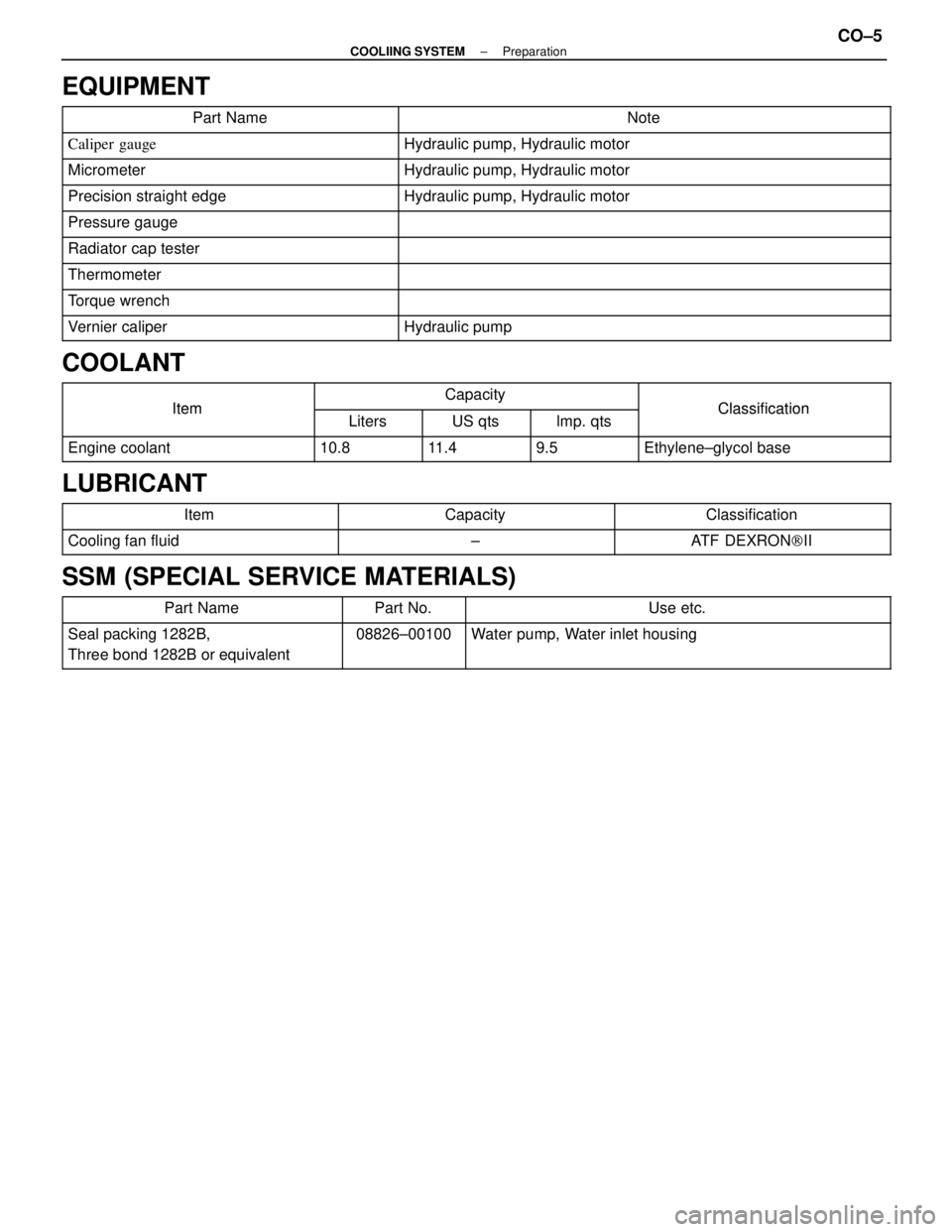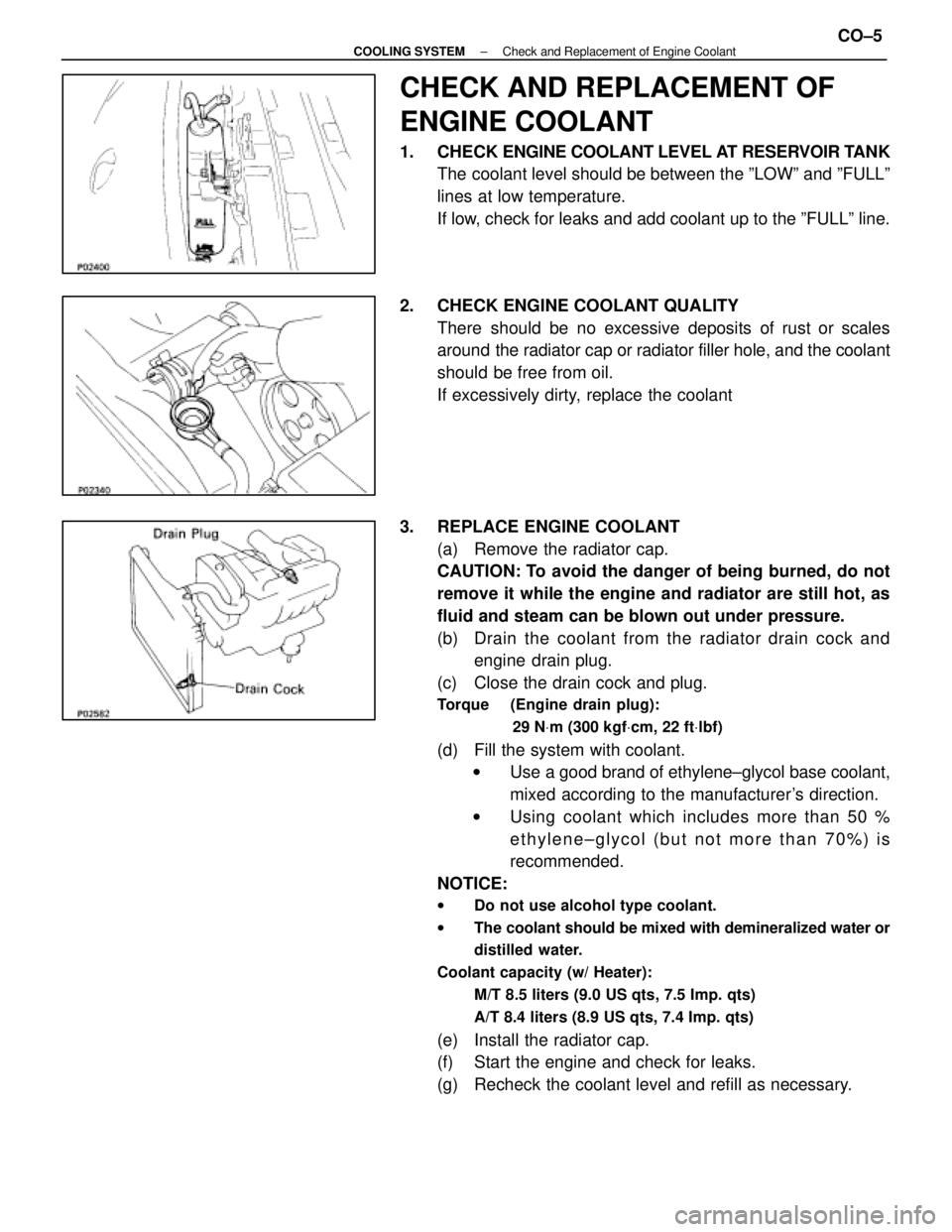Page 1258 of 4087
COOLING SYSTEM
CO±1±
COOLIING SYSTEM Description
WhereEverybodyKnowsYourName
Page 1259 of 4087
DESCRIPTION
This engine utilizes a pressurized forced circulation cooling system which i\
ncludes a hermostat equipped
with a by±pass valve mounted on the inlet side. The cooling system is composed of the water jacket (inside the cylinder bl\
ock and cylinderhead), radiator,
water pump, thermostat, cooling fan, hoses and other components.
OPERATION
CO±2±
COOLIING SYSTEM Description
WhereEverybodyKnowsYourName
Page 1260 of 4087
DESCRIPTION
This engine utilizes a pressurized forced circulation cooling system whi\
ch includes a hermostat equipped
with a by±pass valve mounted on the inlet side. The cooling system is composed of the water jacket (inside the cylinder bl\
ock and cylinderhead), radiator,
water pump, thermostat, cooling fan, hoses and other components.
OPERATION
CO±2±
COOLIING SYSTEM Description
WhereEverybodyKnowsYourName
Page 1261 of 4087

Coolant which is heated in the water jacket is pumped to the radiator, through which a cooling fan blows
air to cool the coolant as it passes through. Coolant which has been coo\
led is then sent back to the engine by
the water pump, where it cools the engine. The water jacket is a network of channels in the shell of the cylinder bloc\
k and cylinderhead through which
coolant passes. It is designed to provide adequate cooling through the cylinders and combus\
tion chambers
which become heated during engine operation.
RADIATOR The radiator performs the function of cooling the coolant which has pass\
ed through the waterjacket and
become hot, and it is mounted in the front of the vehicle. The radiator consis\
ts of an upper tank and lower tank,
and a core which connects the two tanks. The upper tank contains the inlet \
for coolant from the water jacket
and the filler inlet. It also has a hose attached through which excess cool\
ant or steam can flow. The lower tank
contains the outlet for coolant and drain plug. The core contains many t\
ubes through which coolant flows from
the upper tank to the lower tank as well as cooling fins which radiate heat\
away from the coolant in the tubes.
The air sucked through the radiator by the cooling fan, as well as the wind generated by the ve\
hicle's travel,
passes through the radiator, cooling the coolant. Models with automatic transmission include an aut\
omatic
transmission fluid cooler built into the lower tank of the radiator. A cooling fan is mounted behind radiator to assist
the flow of air through the radiator. When the coolant temperature is low, the fan operates slowly to help the warm
up, and when the coolant temperature becomes high, the fan speed is increas\
ed to provide the air flow required
for cooling.
RADIATOR CAP (on Reservoir Tank)
The radiator cap is a pressure type cap which seals the radiator, resulting in pressurization of the radiator
as the coolant expands. The pressurization prevents the coolant from boi\
ling even when the coolant tempera-
ture exceeds 100 5C (212 5F). A relief valve (pressurization valve) and a vacuum valve (negati\
ve pressure valve)
are built into the radiator cap. The relief valve opens and lets steam esca\
pe through the overflow pipe when
the pressure generated inside the cooling system exceeds the limit (coolant temperature: 110±120 5C
(230±248 5F) pressure; 29.4±98.1 kPa (0.3±1.0 kgf/cm2, 4.3±14.2 psi)). The vacuum v\
alve opens to alleviate
the vacuum which develops in the coolant system after the engine is stopped\
and the coolant temperature
drops.
RESERVOIR TANK The purpose of the reservoir tank is to catch coolant overflows created by \
volumetrix expansion when the
coolant temperature increases. The cap of the reservoir tank is a pressure type\
which prevents deterioration
of the LLC (Long Life Coolant) caused by contact with atmospheric air, increases vaporization performance and
reduces loss of the coolant volume.
WATER PUMP The water pump is mounted on the front of the cylinder block and driven by t\
he reverse side of the timing
belt.
THERMOSTAT The thermostat has a wax type by±pass valve and is mounted in the wat\
er inlet housing. The thermostat
begins to open at the temperature of 80 5C (180 5F). When the coolant temperature is low, the valve closes to
prevent coolant flow to the radiator, thus permitting the engine to warm up rapidly. When the by±pass valve
opens the by±pass circuit, the engine coolant continues to circulate \
inside the engine, quickly and uniformly
warming up to the appropriate temperature. When the coolant temperature is high\
, the valve opens and coolant
flows to the radiator where it is cooled. When the wax inside the thermostat \
is heated, it expands and thus
creates pressure which overpowers the force of the spring which keeps the valve\
closed. When the wax cools,
its contraction causes the force of the spring to take effect once more, closing the valve.
ELECTRONICALLY CONTROLLED HYDRAULIC COOLING FAN (See page CO±22)
±
COOLIING SYSTEM DescriptionCO±3
WhereEverybodyKnowsYourName
Page 1263 of 4087

EQUIPMENT
��������������� ���������������Part Name������������������\
���� ������������������\
����Note
��������������� ���������������Caliper gauge������������������\
���� ������������������\
����Hydraulic pump, Hydraulic motor
��������������� ���������������Micrometer������������������\
���� ������������������\
����Hydraulic pump, Hydraulic motor
��������������� ���������������Precision straight edge������������������\
���� ������������������\
����Hydraulic pump, Hydraulic motor��������������� ���������������Pressure gauge������������������\
���� ������������������\
����
��������������� �
��������������Radiator cap tester������������������\
���� �
������������������\
������������������ �
��������������
���������������Thermometer
������������������\
���� �
������������������\
���
������������������\
����
��������������� ���������������Torque wrench������������������\
���� ������������������\
����
��������������� ���������������Vernier caliper������������������\
���� ������������������\
����Hydraulic pump
COOLANT������������ �
�����������
������������Item
�������������� �
�������������
��������������Capacity
������������ �
�����������
������������Classification
������������ ������������
Item
����� �����Liters������ ������US qts����� �����lmp. qts������������ ������������
Classification
������������ ������������Engine coolant����� �����10.8������ ������11.4����� �����9.5������������ ������������Ethylene±glycol base
LUBRICANT
������������� �������������Item������������ ������������Capacity������������� �������������Classification
������������� �������������Cooling fan fluid������������ ������������±������������� �������������ATF DEXRON
[II
SSM (SPECIAL SERVICE MATERIALS)������������� �
������������
�������������Part Name
������ �
�����
������Part No.
������������������\
� �
������������������
������������������\
�Use etc.
������������� �
������������
�������������
Seal packing 1282B,
Three bond 1282B or equivalent������ �
�����
������
08826±00100������������������\
� �
������������������
������������������\
�
Water pump, Water inlet housing
±
COOLIING SYSTEM PreparationCO±5
WhereEverybodyKnowsYourName
Page 1264 of 4087

CHECK AND REPLACEMENT OF
ENGINE COOLANT
1. CHECK ENGINE COOLANT LEVEL AT RESERVOIR TANK
The coolant level should be between the ºLOWº and ºFULLº
lines at low temperature.
If low, check for leaks and add coolant up to the ºFULLº line.
2. CHECK ENGINE COOLANT QUALITY There should be no excessive deposits of rust or scales
around the radiator cap or radiator filler hole, and the coolant
should be free from oil.
If excessively dirty, replace the coolant
3. REPLACE ENGINE COOLANT (a) Remove the radiator cap.
CAUTION: To avoid the danger of being burned, do not
remove it while the engine and radiator are still hot, as
fluid and steam can be blown out under pressure.
(b) Drain the coolant from the radiator drain cock andengine drain plug.
(c) Close the drain cock and plug.
Torque (Engine drain plug):
29 NVm (300 kgf Vcm, 22 ft Vlbf)
(d) Fill the system with coolant.
w Use a good brand of ethylene±glycol base coolant,
mixed according to the manufacturer's direction.
w Using coolant which includes more than 50 %
ethylene±glycol (but not more than 70%) is
recommended.
NOTICE:
w Do not use alcohol type coolant.
w The coolant should be mixed with demineralized water or
distilled water.
Coolant capacity (w/ Heater): M/T 8.5 liters (9.0 US qts, 7.5 Imp. qts)
A/T 8.4 liters (8.9 US qts, 7.4 Imp. qts)
(e) Install the radiator cap.
(f) Start the engine and check for leaks.
(g) Recheck the coolant level and refill as necessary.
±
COOLING SYSTEM Check and Replacement of Engine CoolantCO±5
WhereEverybodyKnowsYourName
Page 1266 of 4087
(f) Slowly add coolant to water inlet housing until it is full.w Use a good brand of ethylene±glycol base coolant,
mixed according to the manufacturer's directions.
w Using coolant which includes more than 50%
ethylene±glycol (but not more 70%) than is
recommended.
NOTICE:
w Do not use alcohol type coolant.
w The coolant should be mixed with demineralized water or
distilled water.
Capacity (w/ Heater): 10.8 liters (11.4 US qts, 9.5 lmp. qts)
(g) Reinstall a new gasket and filler plug to the water inlethousing.
Torque: 44 N Vm (450 kgf Vcm, 33 ft Vlbf)
(h) Slowly add coolant to reservoir tank until it is full.
(i) Reinstall the radiator cap.
(j) Bleed the cooling system.
w Start the engine, and open the heater water valve.
w Maintain the engine speed at 2,000 rpm, and warm
up the engine.
(k) Check for leaks.
(l) Recheck the coolant level and refill as necessary.
±
COOLIING SYSTEM Check and Replacement of Engine CoolantCO±7
WhereEverybodyKnowsYourName
Page 1271 of 4087
THERMOSTAT
HINT: Removing the thermostat would decrease the cooling
efficiency. Do not remove the thermostat, even if it tends to
overheat.
COMPONENTS
REMOVAL OF THERMOSTAT
1. DRAIN ENGINE COOLANT (See page CO±5)
2. REMOVE THERMOSTAT (a) Remove the two nuts holding the water inlet to the water
pump, and disconnect the water inlet from the water
pump.
(b) Remove the thermostat.
(c) Remove the gasket from the thermostat.
CO±10
±
COOLING SYSTEM Thermostat
WhereEverybodyKnowsYourName